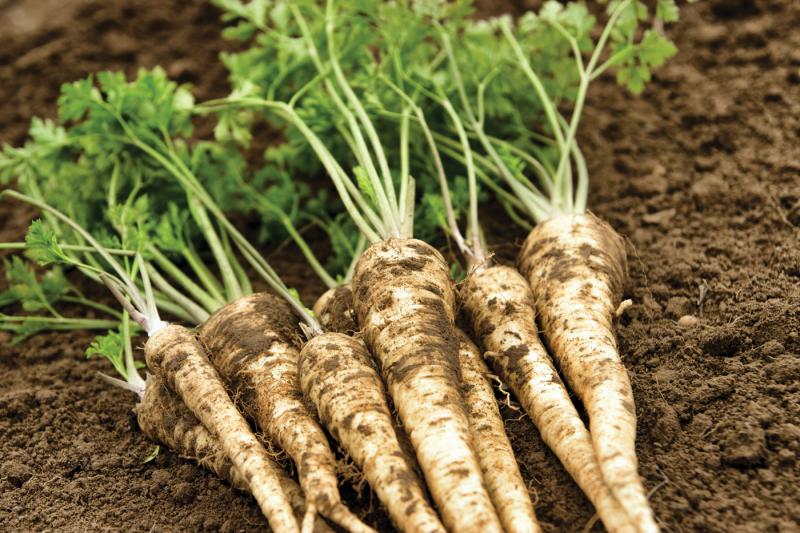Not all salsa is Mexican salsa. Traditional Italian salsa verde sauce is bursting with capers, lemon juice, garlic, anchovies, and of course, parsley. Indeed, parsley probably originated on the Italian island of Sardinia. While we eat parsley leaves for flavoring everything from soups to salsas, imagine my surprise when uprooting the year's parsley crop and finding a long, parsnip-like white root. This is the perfectly edible parsley root that can be eaten raw or cooked and gives a strong parsley flavor to everything from fresh salads to stews. Raw parsley root (Petroselinum crispum) sliced into sticks makes a healthy, crunchy snack and goes well with dips.
Parsley root looks similar to a parsnip, but is whiter and has a less-earthy flavor. It is also called Dutch parsley or Hamburg parsley. The leaves are also edible, although they are a bit more fibrous, and much stronger in flavor than curly or Italian leaf parsley.
Try steaming the roots or roasting them in the oven with a bit of olive oil. Puree parsley root and use the mashed roots as a bed for pot roasts.
Parsley root is a nutrition powerhouse. A single 3.5-ounce raw serving has 55 percent of your daily need for vitamin C, and 45 percent of the daily value of vitamin B9 (folate). It is also high in fiber, zinc, potassium, magnesium and phosphorus.
Our word parsley comes from the Greek Petros, meaning “stone” because these hardy plants are often found growing wild in stony ground.
Plant root parsley 1/8 to 1/4 inch deep two to three inches apart. For better germination, soak the seeds overnight. For best root development make sure your soil is loose, and you may want to add compost or peat moss. Keep the bed well watered, but not soggy. Keep weeds at a minimum.
Parsley is notoriously slow to germinate, and you might not see any sprouts for several weeks. You can also start the seeds indoors a month or two before your last spring frost and transplant them into the garden once the soil has warmed up. Use a liquid organic fertilizer on the young plants every week or two. After the parsley is a few inches high, thin so that plants stand several inches apart.
You can harvest any parsley roots, but if you want to grow varieties selected just for their roots try getting seeds from your local nursery or by mail from companies such as Pinetree Garden Seed (phone 207-926-3400, by mail at P.O. Box 300, New Gloucester, ME 04260 or online at superseeds.com) or Victory Seed Company (P.O. Box 192, Molalla, OR 97038, phone 503-829-3126 or online at victoryseeds.com).
As with most root vegetables, root parsley flavor improves after a light frost. Dig the roots with a garden fork, being careful that you do not cut or bruise the roots.
All parsley is hardy and will often overwinter, especially if you add a light mulch over it before winter.
You can store parsley root in the refrigerator where it will keep for two to three weeks.
So, when you clean up your garden in the fall, don't throw out the roots to your parsley. Shred them into a crisp slaw or deep fry them for parsley French fries. You can even make a wonderful autumn soup with pumpkin, parsley root and thyme. Or whip up a batch of Italian salsa for a winter treat with its roots literally in Sardinia.





















































